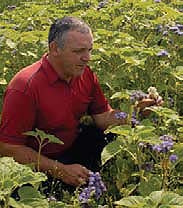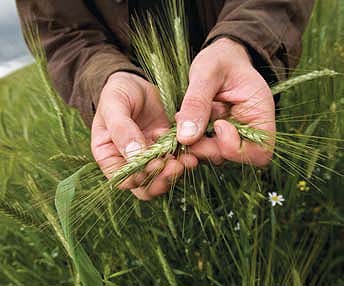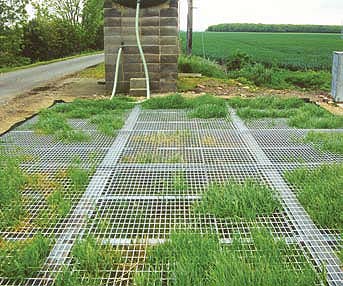Integrated crop management cuts costs and benefits wildlife

In association with the Environment Agency
James Hinchliffe (pictured) farms a 142-hectare arable unit with an alluvial soil in East Yorkshire. For over ten years he has run fungicide trials at the farm alongside conservation practices designed to improve biodiversity. This work, conducted in partnership with BASF, has helped increase the number and variety of birds visiting the farm.
 All fields originally had six-metre margins, now reduced to three metres. The margins are sown with a wide range of plants to provide a variety of food sources for birds throughout the year. Mr Hinchliffe has also adopted a minimum tillage cultivation system, which allows the survival of more beneficial insects that live in the soil during winter.
All fields originally had six-metre margins, now reduced to three metres. The margins are sown with a wide range of plants to provide a variety of food sources for birds throughout the year. Mr Hinchliffe has also adopted a minimum tillage cultivation system, which allows the survival of more beneficial insects that live in the soil during winter.
While not directly increasing farm income, the new cultivation techniques have reduced crop establishment costs (see below). The ditches left un-mown provide food and cover for birds. Uncultivated margins can also be used to access the fields occasionally without adversely affecting biodiversity.
“Arable farming methods can operate alongside an enhanced biodiverse environment, encouraging large numbers of small birds to my farm,” Mr Hinchliffe says.
Counting the cost and reaping the benefits
• Using a minimum-tillage system and stale seedbed saves machinery passes.
• At 2008 prices conventional cultivation costs are about £110 per hectare, so you can save at least £22 per hectare – mainly on fuel and labour
• This approach also reduces the risk of runoff and erosion damage
• Mr Hinchliffe has found that the time and money he is saving on cultivations significantly outweigh the added costs he has to consider because he is not ploughing – a little extra time spent walking his crops to identify weed problems and the herbicides he uses to deal with these weeds. The farm has not had to do any summer spraying to control aphids for over a decade, in part because of a surge in beneficial insect populations under minimum tillage
Integrated crop management
Integrated crop management brings together various techniques to reduce costs and protect the environment, says the Environment Agency’s Paul Meakin. Crop rotation reduces weeds, pests and diseases by interrupting their life cycles. Some crops, such as brassicas, potatoes and sugar beet, need rotations to be longer than four years to control soil-borne pests and diseases.
“You can reduce the herbicide needed within a growing crop if you encourage annual weeds and volunteers to germinate and then treat them before drilling the crop,” he says.
Helpful hints:
• Rotate crops to suit your soil type and farming business.
• Develop a crop protection management plan for your farm – see www.voluntaryinitiative.org.uk
• Incorporate straw to increase organic matter and improve soil fertility
• Select disease-resistant varieties for fields that are more prone to particular pests and diseases
• Leave a rough seedbed and drill as late as possible in the autumn to reduce weed competition, insect damage and soil erosion
• Take all reasonable steps to prevent the spread of pernicious weeds (such as ragwort) and invasive non-native species (such as Japanese knotweed)
Planning pesticide applications and using sprays wisely Mr Meakin says farmers can reduce costs by choosing the appropriate pesticide and ensuring that its application is well targeted and timely.
Mr Meakin says farmers can reduce costs by choosing the appropriate pesticide and ensuring that its application is well targeted and timely.
“Often there is no alternative but to use a chemical treatment to solve a specific disease, weed or pest problem. But there are a number of ways to optimise the inputs you use.
“Walk your crops regularly to identify early signs of attack or weed growth. Anticipate insect attacks and disease outbreaks by using weather forecasts, diagnostic techniques, industry warning networks and decision support systems. Dealing with problems early makes it possible to reduce your use of chemicals.”
Where appropriate, use low-volume applications, he suggests. “Make sure your applications are effective by using the appropriate rates through the correct nozzles in suitable weather conditions.
The slug pellet pesticide, metaldehyde, has recently been found in rivers as a result of its use in farming. Store, handle and apply pellets in line with guidance from the Voluntary Initiative, ensuring that there are no farmyard or field pathways where runoff can carry slug pellets into ditches and streams.”
Helpful hints:
• Walk crops regularly to check for problems. Record weed infestations, and use the information to identify problem areas in future years
• Use a Local Environment Risk Assessment for Pesticides where required
• Reduce applications and prevent pollution by establishing six-metre buffer strips next to watercourses and sensitive areas
• Monitor insect and disease levels using traps, bait and diagnostic kits. Only take action when treatment thresholds are reached
• Calibrate your sprayer each time you use it
• Keep a copy of Defra’s plant protection code of practice on your farm. Familiarise everyone who works with pesticides with the requirements of the Food and Environment Protection Act 1985
Storing, handling and disposing of pesticides
Poor handling or inappropriate use of pesticides can pollute the environment and harm wildlife, Mr Meakin warns. He says pesticides should be kept in a secure, bunded store to reduce the risk of theft and pollution from leaks.
“Use a dedicated area for filling and cleaning your sprayer, with disposal facilities that won’t adversely affect drains, watercourses, soakaways, wells and boreholes. Use a pressurised clean water supply for washing down.”
Farmers can collect and dispose of sprayer washings in a number of ways:
• Spray over the crop that has just been treated
• Establish an approved treatment system
• Employ an approved disposal contractor
• Spray onto a designated vegetated area of land (groundwater authorisation required from the Environment Agency)
• Use a permitted lined ‘biobed’ system
 A biobed (pictured) is a lined structure filled with biomix: a mixture of topsoil, a peat substitute and straw. The biomix removes the pesticides from contaminated water, which can then be re-used.
A biobed (pictured) is a lined structure filled with biomix: a mixture of topsoil, a peat substitute and straw. The biomix removes the pesticides from contaminated water, which can then be re-used.
Research has shown that pesticide pollution originating from the farmyard can be reduced by as much as 99% when biobed-based handling areas are used.
If using contractors, Mr Meakin says to ensure that they are members of the National Register of Sprayer Operators. “Make sure that they know where the wells, drains, boreholes, soakaways and watercourses are on your farm, and that they use suitable sites for filling and cleaning equipment. They should comply with any Local Environment Risk Assessment for Pesticides (LERAP) where this applies. They should also calibrate sprayers before use and record all applications, passing on the details to you.”
Helpful hints:
• Have an emergency plan accessible to all staff and contractors to help deal with pesticide spills
• Keep cat litter or other absorbent material in your pesticide store and near your filling area, ready to mop up spills
• Use stored water or a bowser to fill your sprayer. Only use a mains supply if it is fitted with a double-check valve
• Check your sprayer for drips, leaks and hose condition before leaving the yard
• Avoid handling pesticides near an open drain or watercourse
• Wash the outside of the sprayer and tractor tyres before leaving the field
• Get a permit from us if you dispose of chemicals or washings on your farm other than by application to the crop
• Dispose of all non-approved pesticides safely through a licensed contractor – see www.recycling.org.uk
• Use pesticides in accordance with advice on the label, the recommendations of a BASIS-registered adviser and the principles of integrated control
Encouraging predators of crop pests
Many crop pests have natural predators that can help your pest control, says Mr Meakin. “You can plant grass strips around arable field margins to provide shelter for beneficial insects, a buffer against competitive weeds and a useful habitat for wildlife. Where fields are too big for margins to be effective havens for insects, consider splitting the field with a beetle bank sown with tussock grasses such as cocksfoot and Yorkshire fog. Beetle banks along contour lines have the added benefit of reducing runoff and soil erosion.
“Managed field margins of the right height and width can reduce the risk of spray drift affecting hedgerows and watercourses.”
Helpful hints:
• Make use of grants for beetle banks and margins
• Use fallow land to provide additional insect refuges
• Plant non-invasive perennial grass species such as red fescue and smooth meadow grass to compete with aggressive annual weeds
• Consider including native perennial wildflowers in your seed mix for field margins, to provide food for birds
